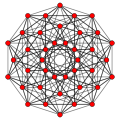Five-dimensional space
This article has multiple issues. Please help improve it or discuss these issues on the talk page. (Learn how and when to remove these messages)
|

A five-dimensional space (5D) is a space with five dimensions.
Five-dimensional Euclidean geometry
[edit]5D Euclidean geometry designated by the mathematical sign: 5 [1] is dimensions beyond two (planar) and three (solid). Shapes studied in five dimensions include counterparts of regular polyhedra and of the sphere.
Polytopes
[edit]In five or more dimensions, only three regular polytopes exist. In five dimensions, they are:
- The 5-simplex of the simplex family, {3,3,3,3}, with 6 vertices, 15 edges, 20 faces (each an equilateral triangle), 15 cells (each a regular tetrahedron), and 6 hypercells (each a 5-cell).
- The 5-cube of the hypercube family, {4,3,3,3}, with 32 vertices, 80 edges, 80 faces (each a square), 40 cells (each a cube), and 10 hypercells (each a tesseract).
- The 5-orthoplex of the cross polytope family, {3,3,3,4}, with 10 vertices, 40 edges, 80 faces (each a triangle), 80 cells (each a tetrahedron), and 32 hypercells (each a 5-cell).
An important uniform 5-polytope is the 5-demicube, h{4,3,3,3} has half the vertices of the 5-cube (16), bounded by alternating 5-cell and 16-cell hypercells. The expanded or stericated 5-simplex is the vertex figure of the A5 lattice, ![]()
![]()
![]()
![]()
![]()
![]()
![]() . It and has a doubled symmetry from its symmetric Coxeter diagram. The kissing number of the lattice, 30, is represented in its vertices.[2] The rectified 5-orthoplex is the vertex figure of the D5 lattice,
. It and has a doubled symmetry from its symmetric Coxeter diagram. The kissing number of the lattice, 30, is represented in its vertices.[2] The rectified 5-orthoplex is the vertex figure of the D5 lattice, ![]()
![]()
![]()
![]()
![]()
![]()
![]() . Its 40 vertices represent the kissing number of the lattice and the highest for dimension 5.[3]
. Its 40 vertices represent the kissing number of the lattice and the highest for dimension 5.[3]
| A5 | Aut(A5) | B5 | D5 | ||
|---|---|---|---|---|---|
 5-simplex {3,3,3,3} |
 Stericated 5-simplex |
 5-cube {4,3,3,3} |
 5-orthoplex {3,3,3,4} |
 Rectified 5-orthoplex r{3,3,3,4} |
 5-demicube h{4,3,3,3} |
Other five-dimensional geometries
[edit]The theory of special relativity makes use of Minkowski spacetime, a type of geometry that locates events in both space and time. The time dimension is mathematically distinguished from the spatial dimensions by a modification in the formula for computing the "distance" between events. Ordinary Minkowski spacetime has four dimensions in all, three of space and one of time. However, higher-dimensional generalizations of the concept have been employed in various proposals. Kaluza–Klein theory, a speculative attempt to develop a unified theory of gravity and electromagnetism, relied upon a spacetime with four dimensions of space and one of time.[4]
Geometries can also be constructed in which the coordinates are something other than real numbers. For example, one can define a space in which the points are labeled by tuples of 5 complex numbers. This is often denoted . In quantum information theory, quantum systems described by quantum states belonging to are sometimes called ququints.[5][6]
See also
[edit]References
[edit]- ^ Güler, Erhan (2024). "A helicoidal hypersurfaces family in five-dimensional euclidean space". Filomat. 38 (11). Bartın University: 3814 (4th para.;1st sent.). doi:10.2298/FIL2411813G.
- ^ "The Lattice A5". www.math.rwth-aachen.de.
- ^ Sphere packings, lattices, and groups, by John Horton Conway, Neil James Alexander Sloane, Eiichi Bannai [1]
- ^ Zwiebach, Barton (2004). A First Course in String Theory. Cambridge University Press. pp. 14–16, 399. ISBN 0-521-83143-1.
- ^ Jain, Akalank; Shiroman, Prakash (2020). "Qutrit and ququint magic states". Physical Review A. 102 (4): 042409. arXiv:2003.07164. doi:10.1103/PhysRevA.102.042409.
- ^ Castelvecchi, Davide (2025-03-25). "Meet 'qudits': more complex cousins of qubits boost quantum computing". Nature. Retrieved 2025-05-11.
Further reading
[edit]- Wesson, Paul S. (1999). Space-Time-Matter, Modern Kaluza-Klein Theory. Singapore: World Scientific. ISBN 981-02-3588-7.
- Wesson, Paul S. (2006). Five-Dimensional Physics: Classical and Quantum Consequences of Kaluza-Klein Cosmology. Singapore: World Scientific. ISBN 981-256-661-9.
- Weyl, Hermann, Raum, Zeit, Materie, 1918. 5 edns. to 1922 ed. with notes by Jūrgen Ehlers, 1980. trans. 4th edn. Henry Brose, 1922 Space Time Matter, Methuen, rept. 1952 Dover. ISBN 0-486-60267-2.



